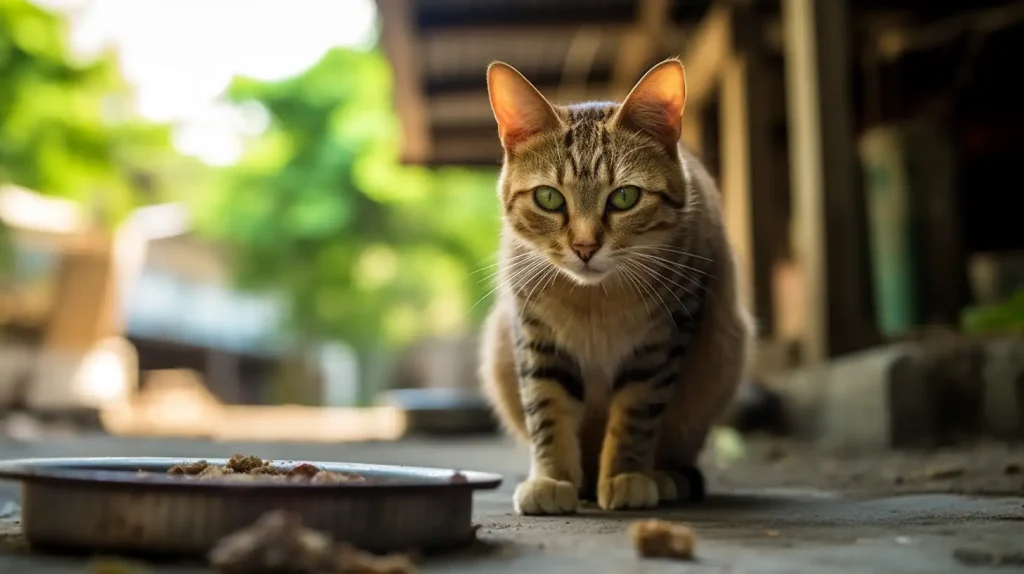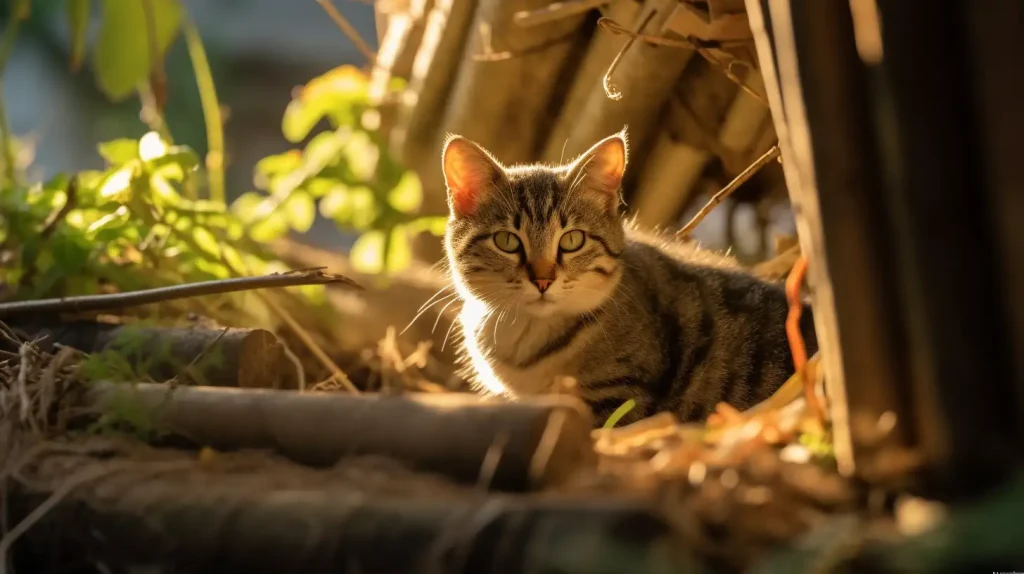Table of Contents
Have you ever wanted to start a big argument online? Just pose the question of whether you should feed stray cats or not and then step back. You will absolutely get what you came for. The question of whether a stray cat should be fed or not is a very emotionally charged one that evokes passionate responses. Here’s another question that gets people revved up:
If you feed a stray cat, will it stay?
In a word, yes. I could end this article right here and be done with it, but that’s not why you’re here. It is also not why this website exists. So for the benefit of all my readers, this article will explain why stray cats will hang around after being fed and why you should think twice about doing it.
A Letter to an Expert
I will begin by referencing a 2017 letter written to Mercury News in San Jose, California. The letter was written by a local resident to one of the lifestyle editors, Joan Morris, who apparently specializes in these sorts of things.
The letter writer needed some advice because she had been feeding a group of feral cats in her local park for quite some time. So used to her daily visits were they, that the cats used to line up by the road anticipating her arrival. She could barely get out of her car before they all started begging for food.
Unfortunately, the woman was placed in a position where she might have to move. She wanted to know what would happen to the cats if she was no longer there to feed them. She also wanted to know if there is a way to slowly wean them from the food she was providing.
To her credit, the editor did not address whether the letter writer should have started feeding the cats to begin with. What’s done was done, she explained. But she did lay out the truth. She explained that those cats would go in search of food if the letter writer stopped showing up. Some of them would survive, others would not.
In fairness, feral cats are distinctly different from strays in a number of different ways. But the one thing they both have in common is survival. Both feral and stray cats – like every other animal on the planet – are programed to do two things: survive and procreate.
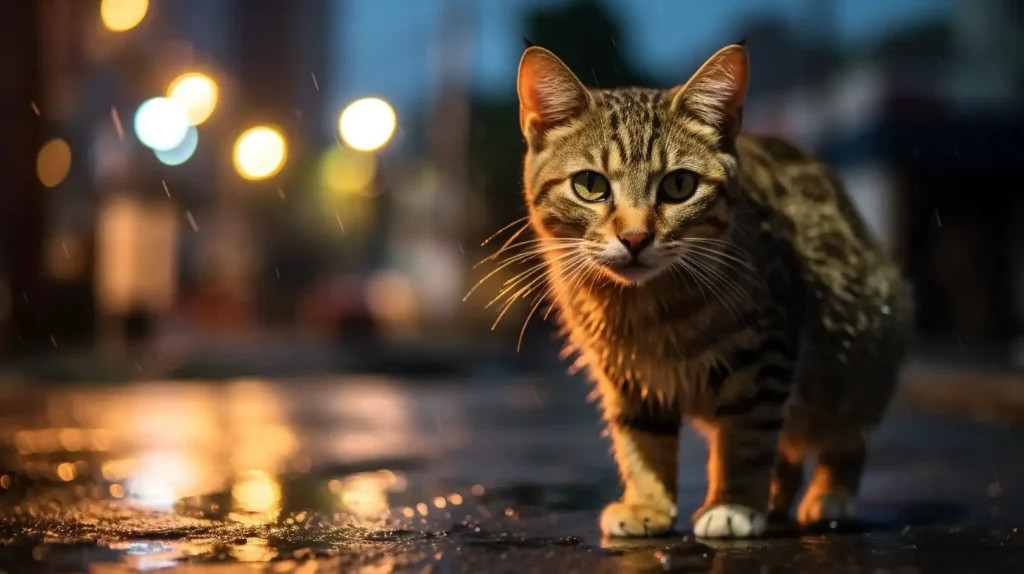
Feeding a Stray Cat
Stray cats may be domesticated animals, but they are still animals nonetheless. As such, they do not care about your health and welfare. They care about survival and procreation. If they have to destroy your property to feed and breed, they will. If they have to fight with a neighbor’s cat or dog, they will.
This isn’t to say that you should not feed a stray cat. Perhaps you should, which will be addressed in just a minute. The point of talking about stray cats as animals interested only in their own survival is to help you understand that we are not talking about human beings here. We cannot approach the question of feeding by attaching human rights and characteristics to cats. They are animals.
Whether an outdoor cat is stray or feral, it will search for food wherever it can be found. Furthermore, a stray cat will take the easy way out. It will always accept food from humans rather than going out and hunting by itself – because it is just easier to do.
Appropriate Food
If you choose to feed a stray cat, understanding what type of food is appropriate is essential. Cats, unlike dogs, are obligate carnivores. This means that they need a diet primarily made up of meat to thrive. Ideally, if you have cat food available, either wet or dry, that would be the best choice. These foods are specially formulated to provide cats with the nutrients they require, including the essential amino acid taurine, which cats cannot produce on their own.
However, if cat food isn’t immediately available, lean cooked meats such as chicken or turkey can be a good substitute. Fish can also be offered but should be cooked and deboned, as raw fish and bones can cause health issues for cats. Remember to keep these meals simple and avoid using any seasonings, oils, or sauces, as these can be harmful to cats.
Food to Avoid
Avoid giving cats milk or dairy products as many cats are lactose intolerant and can have digestive issues as a result. Also, keep them away from chocolate, caffeine, onions, garlic, alcohol, and certain artificial sweeteners like xylitol, as these are all toxic to cats.
You and I are no different. There is a reason most of us don’t go out into the woods every weekend in a desperate attempt to hunt for the food that will carry us through the next week. It’s a lot easier to go to the grocery store and fill up a cart. There is no mess, no blood, very little work, etc. Animals are no different.
Feed a stray cat once and you can bet the animal will come around a second time looking for food. If you feed the animal a second time, you are reinforcing the behavior. It will come around again, and again. It will keep on coming as long as food is readily available. That’s why, if you choose to feed a stray cat, it’s crucial to provide appropriate, nutritious food while considering the broader implications.
Some Foods a Stray Cat Can and Cannot Eat
Please note that while this list covers some common foods, it is by no means exhaustive. Always consult with a veterinarian if you are unsure whether a certain food is safe for a cat.
| Food | Can Cats Eat It? | Reason |
|---|---|---|
| Tuna (canned) | Occasionally | While tuna can provide protein and omega-3 fatty acids, excessive consumption can lead to mercury poisoning. |
| Dairy Products | No | Most cats are lactose intolerant, which means that they can’t digest lactose in dairy products. This can lead to diarrhea and gastrointestinal upset. |
| Cooked Fish and Poultry | Yes | They are good sources of protein and can be easily digested by cats. Bones should be removed to prevent choking. |
| Raw Fish and Poultry | No | Raw meat can contain harmful bacteria like Salmonella and E. coli. Also, an enzyme in raw fish can lead to vitamin B deficiency in cats. |
| Bones | No | Small or cooked bones can splinter and cause choking or harm to a cat’s digestive tract. |
| Dog Food | No | Dog food lacks the essential nutrients that cats need. Long-term feeding can lead to malnutrition. |
| Chocolate | No | Chocolate contains theobromine, a substance that is toxic to cats. It can lead to heart problems, muscle tremors, or seizures. |
| Grapes and Raisins | No | These can cause kidney damage in cats, though the exact substance causing the toxicity is unknown. |
| Garlic and Onions | No | They contain compounds that can cause damage to red blood cells in cats, leading to anemia. |
| Alcohol | No | Alcohol can cause dangerous alcohol poisoning in cats. Even small amounts can lead to severe health issues. |
| Caffeine | No | Caffeinated drinks like tea, coffee, and energy drinks can cause restlessness, rapid breathing, heart palpitations, and muscle tremors in cats. |
| Cat Food (Wet or Dry) | Yes | Cat food is specifically formulated to contain all the nutrients that cats need in their diet. |
The Health Risks of Feeding Stray Cats
When we see a stray cat, our first instinct as compassionate humans might be to provide it with food. While this is an act of kindness, it’s essential to understand the health risks associated with feeding stray cats.
Potential Health Risks to Humans
One concern lies in the potential transmission of diseases from cats to humans, a phenomenon known as zoonosis. Stray cats, unlike domesticated ones, often lack vaccinations and regular veterinary care. Consequently, they can harbor diseases like rabies, cat scratch fever, or parasites such as fleas and ticks, which can cause Lyme disease.
Furthermore, stray cats may react unpredictably when approached. Even if a stray appears friendly, there’s a risk of injury from scratches or bites, particularly if the cat feels threatened. Such injuries can lead to bacterial infections, such as Pasteurella multocida, which requires prompt medical attention.
Potential Health Risks to Cats
Equally important are the potential health risks to the stray cats themselves. Feeding stray cats with food intended for human consumption or low-quality pet food can lead to malnutrition or digestive issues in cats. Certain human foods can even be toxic to cats, including chocolate, onions, and certain artificial sweeteners.
Moreover, regular feeding might make the stray cats reliant on human-provided food, further decreasing their ability to fend for themselves. They might also come into conflict with other animals or face danger from traffic while traveling to the feeding site.
It’s important to remember that while our intentions might be good, the act of feeding stray cats without taking further steps for their care may inadvertently cause harm to both the cats and ourselves. However, this doesn’t mean we should turn a blind eye. There are safer and more effective ways to help stray cats, such as participating in or supporting Trap-Neuter-Return (TNR) programs, and advocating for responsible pet ownership to prevent cats from becoming strays in the first place.
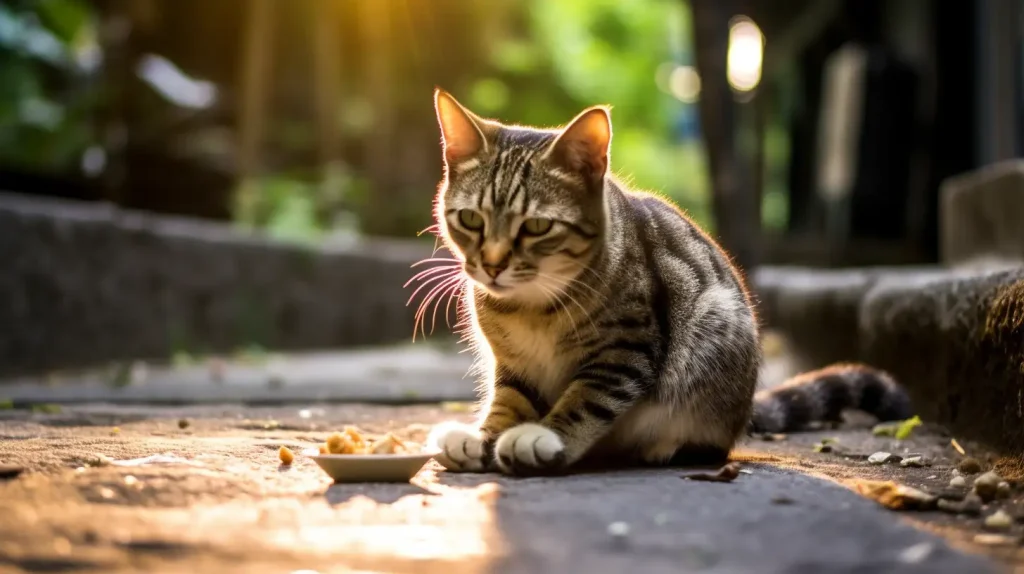
Why Feeding a Stray Cat is Not Good for Them
Now we get to the tricky part of the answer here. This section and the next will address feeding a stray cat under one of two conditions. The first is feeding the cat with no intention of taking it into your own home or making a real effort to find its original owner or a new home. This is not good for the animal.
Stray cats already have a challenging time hunting because they did not learn to do it when they were young. Remember, strays are former house cats that have either been abandoned or lost. They are so used to human contact and provision that they simply don’t know how to hunt properly.
For this reason, a lot of stray cats are terribly malnourished. But remember an animal’s top two priorities: survival and procreation. A stray cat motivated by desperation will figure out how to hunt one way or the other. If it cannot succeed by killing mice, rats, and other animals, it will seek out sources of garbage on which to feed.
On the other hand, continuing to feed a stray cat continues to exacerbate the problem. Feed one cat and you’ll have a second drop by, then a third, and so on. Eventually you will not have enough food for all of them. You will slowly starve them to death.
Also understand that unless those cats have been spayed or neutered, they will continue procreating. Their kittens will not have enough food either. Now you’ll have adult cats competing with their own kittens for food. The result will not be pretty.
The Psychological Aspect of Feeding Stray Cats
The impulse to feed stray cats can often be traced back to our innate sense of empathy and compassion. Encountering an animal in a state of need can tug at the heartstrings, and offering food seems like a straightforward and immediate way to help. In many ways, it’s a basic expression of our shared instinct to nurture and provide care.
From a psychological perspective, this act of giving is not just about alleviating the cat’s hunger; it also provides the person feeding the cat with a sense of purpose and satisfaction. It can be a form of altruism where the primary beneficiary is not just the cat, but also the individual who gains emotional gratification from the act of kindness.
The Emotional Connection
At a deeper level, feeding stray cats can also create a unique emotional bond. The connection forged over shared moments – seeing a wary cat gradually learn to trust, or witnessing the joyous abandon of a hungry cat savouring a meal – can be profoundly rewarding. This interaction can also provide a sense of companionship, a point of connection to the natural world, or even a welcome respite from human-centric concerns.
However, it’s important to remember that, while these feelings are undeniably powerful, they should be balanced with a clear understanding of the potential implications of feeding strays, both for the cats themselves and for the wider ecosystem.
The Sense of Responsibility
Moreover, the act of feeding a stray cat often instills a sense of responsibility in the feeder. Regularly providing food can lead to a feeling of guardianship over the cat, further strengthening the emotional bond. This sense of responsibility can be a powerful motivator, encouraging individuals to take further steps such as arranging for medical care, or seeking advice on more sustainable forms of support like trap-neuter-release programs.
Taking a Stray In
If you decide to take the compassionate route and provide a stray cat with a home, there are several steps you should follow to ensure a safe and smooth transition for both you and the animal.
Assessing the Cat’s Health: The first step should be to take the cat to a veterinarian for a health assessment. This is a crucial step as stray cats may have been exposed to various diseases or may have parasites, and it’s important to address these health concerns before introducing the cat to your home, especially if you have other pets. The vet can conduct a thorough examination and perform necessary tests to assess the cat’s health condition.
Getting the Cat Vaccinated: After initial health assessments, it’s important to make sure the cat is up to date on its vaccinations. Vaccines for rabies, feline distemper, and feline leukemia are particularly important. Vaccinating the cat will not only protect it from catching these diseases but also prevent it from spreading them to other animals.
Spaying or Neutering the Cat: Another essential step is to have the cat spayed or neutered. This will prevent it from contributing to the existing overpopulation problem of stray and feral cats. Your veterinarian can give you more information about the procedure and its benefits.
Gradual Introduction to the Home Environment: Transitioning a stray cat into a home environment should be done gradually and patiently. Initially, provide the cat with a small, quiet, and safe space like a bathroom or a separate room where it can adjust to its new surroundings. You can gradually introduce the cat to the rest of your home and any other pets you may have. Use positive reinforcement to build trust and help the cat feel safe and comfortable.
Routine and Consistency: Stray cats may not be used to a routine, and establishing one can help them adjust to their new environment. Consistent feeding times, play sessions, and periods of quiet can provide a sense of security for your new pet.
Under these circumstances, a stray cat can make a wonderful addition to your family. You will not only provide the animal with shelter, food, and care but also get the opportunity to enjoy its companionship.
However, if you are not willing to undertake this responsibility, it’s important to understand that continuing to feed a stray cat without offering it a stable home may contribute to an uncontrolled animal population and create further problems. While it might seem harsh, nature has its own ways of maintaining balance. In this context, any animal population can quickly become troublesome if not regulated properly. Nature, with its indiscriminate laws, does an efficient job in controlling this balance; it’s often human intervention that can lead to imbalance. Therefore, well-intentioned actions like feeding stray cats should be accompanied by responsible steps like adoption, health care, and population control.
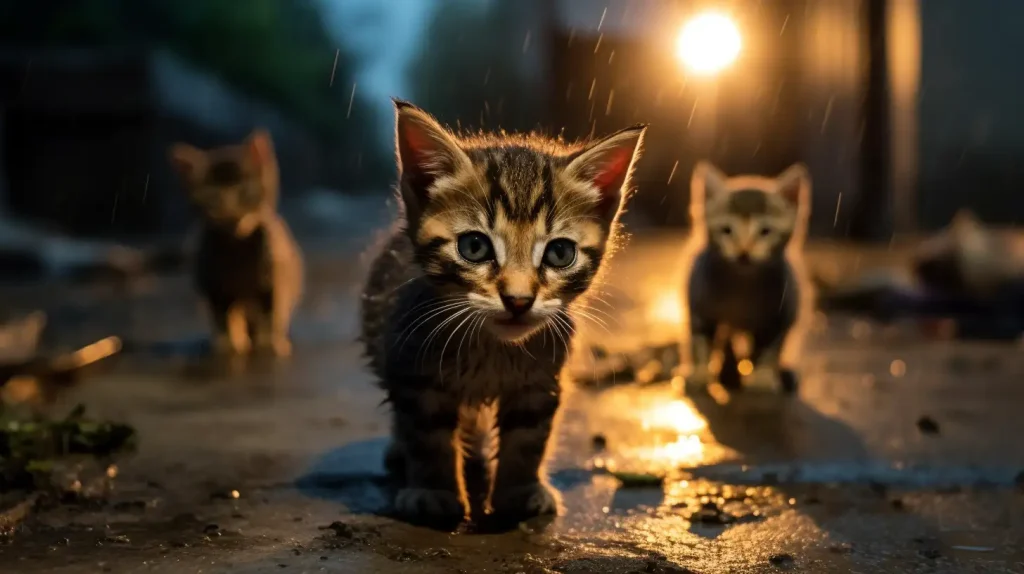
Does Your Town Have a Feeding Ban?
Another thing to consider in relation to whether you should feed a stray cat or not is the law. There are plenty of communities throughout the United States for example that have banned feeding both stray and feral cats. The bans are well-intentioned, allowing nature to run its course in order to control cat populations. Unfortunately, the Humane Society explains that feed bans don’t really work.
They explain that feeding bans are nearly impossible to enforce. And while this may seem like a good thing, it actually makes the problem worse. Why? Because there will always be a handful of people willing to feed both stray and feral cats. The cats continue to reproduce, growing their populations exponentially.
Growing cat populations can cause a lot of problems for municipalities. They harm public and private property; they spread disease amongst themselves; they present a danger to other animals.
The point of this is to say that you need to check local ordinances before you choose to start feeding a stray cat. If the law says you cannot do it, then it’s up to you to decide whether you want to break the law. If you are going to do it though, have a heart and adopt the cat as your own.
The Environmental Impact of Feeding Stray Cats
When considering feeding stray cats, we must also consider the potential environmental impacts this action may precipitate. Cats, even those that are well-fed, maintain their instinctual drive to hunt. This inherent behavior can lead to negative consequences for local wildlife populations, especially in urban and suburban areas where cats and wildlife interact regularly.
Impact on Local Wildlife
Despite being well-fed, a stray or feral cat’s instinct to hunt remains strong, often resulting in the killing of birds, rodents, and other small animals. For some species already struggling with habitat loss and other environmental pressures, additional predation by cats can have a significant impact on their populations. According to a study conducted by the Smithsonian Conservation Biology Institute and the U.S. Fish and Wildlife Service, free-ranging domestic cats are estimated to kill 1.3 to 4.0 billion birds and 6.3 to 22.3 billion mammals annually in the United States alone. As such, the sheer number of cats, both owned and unowned, contributes significantly to these mortality rates.
Disruption of Ecosystems
When we feed stray cats and unintentionally promote their proliferation, we may be indirectly disrupting delicate ecosystems. Stray and feral cats can outcompete native predators, disrupting local food webs and potentially causing declines in native predator populations. The presence of cats in the environment can also lead to behavioral changes in other wildlife, as they modify their behaviors to avoid these non-native predators.
Feeding stray cats, while well-intentioned, can have a ripple effect on the environment that extends beyond the immediate locale. To mitigate these impacts, one could consider alternatives such as supporting animal shelters or advocating for spay/neuter programs.
Trap, Neuter, Release
The strategy known as Trap, Neuter, Release (TNR) is one recognized and supported by the Humane Society and various other advocacy groups globally. It offers a humane and effective approach to managing stray and feral cats. By trapping these cats, having them spayed or neutered, and then releasing them back into their habitats, we can prevent further population growth while still allowing the cats to live out their lives naturally.
Getting Involved in TNR
Communities often have organizations or groups actively managing TNR programs. These groups consist of trained volunteers who know how to safely trap a stray or feral cat. If you notice a stray cat in your neighborhood, contact these groups. Providing them with details about the cat’s regular location and behavior can help them trap the animal more effectively.
In some regions where stray and feral cat populations are exceedingly high, local authorities and charities may lack the resources to perform TNR on all cats. In these cases, they may invite local residents to assist in the trapping process. If you’re interested, these organizations typically offer guidance and training to ensure that you can safely trap a cat without causing it stress or harm.
Performing TNR
Performing TNR involves several key steps:
- Trapping: Safe and humane cat traps are often used for this step. These are designed so that the cat can walk in, usually lured by some food, triggering the entrance to close behind them.
- Neutering: After the cat is trapped, it’s brought to a vet or a local clinic where it’s spayed or neutered. During this time, the cat might also receive other necessary medical treatments, such as vaccinations or wound care.
- Recovery: Post-surgery, the cat needs time to recover. This step takes place in a controlled environment where the cat’s health can be monitored.
- Release: Once the cat is fully recovered, it’s released back to the location where it was trapped. This is important, as cats are territorial and may not fare well if released into unfamiliar areas.
Supporting TNR Programs
Even if you cannot actively participate in trapping or housing cats for recovery, you can still support TNR programs. Consider donating to local organizations or volunteering in non-trapping roles, such as assisting with fundraising events, spreading awareness about the program, or helping to care for cats during their recovery period.
Remember, TNR isn’t just about controlling cat populations. It’s also about creating a healthier environment for both the cats and the communities they live in. By getting involved in TNR, you can contribute to a more humane and effective solution for managing stray and feral cats.

Alternative Methods of Helping Stray Cats
Providing assistance to stray cats does not always necessitate direct feeding or adopting them into your home. There are numerous other ways to help improve their lives and, at the same time, manage their population in a sustainable and humane manner.
Support Local Animal Shelters
Animal shelters play a crucial role in rescuing, rehabilitating, and rehoming stray and abandoned cats. By offering financial aid or supplies, you can help these establishments continue their work. Many shelters welcome donations of cat food, cat litter, toys, and even old towels or blankets that can be used for bedding. Volunteering your time is another wonderful way to contribute. Shelters often need help with feeding, cleaning, socializing animals, or assisting with administrative tasks.
Advocacy and Education
Advocacy is a powerful tool for effecting change at the societal level. By educating yourself and others about the plight of stray cats, you can help shift public opinion and encourage more responsible pet ownership. This might involve campaigning for local laws that promote spaying and neutering, or advocating for the humane treatment of stray and feral cats in your community. Use social media platforms, community outreach events, or local media to spread awareness and promote understanding about the issues stray cats face.
Spaying and Neutering
Supporting spaying and neutering initiatives is perhaps one of the most impactful ways to help stray cats. These surgical procedures prevent unwanted litters, thereby helping to control the stray and feral cat population. Many cities have low-cost or free spay/neuter programs that you can contribute to, either financially or by volunteering.
Trap-Neuter-Release Programs
Participating in, or supporting TNR programs can be an effective way to aid stray and feral cats. Some communities have local TNR programs which welcome volunteers and donations.
By exploring these alternative methods, you can contribute to the well-being of stray cats in a way that aligns with your abilities and comfort level. Each act, no matter how small, can make a big difference in the lives of these animals.
If You Feed a Stray Cat Will It Stay – Conclusion
This article has offered you quite a bit of information to help you decide whether you should feed a stray cat or not. Ultimately, the choice is yours. But understand that if you feed a stray cat, it will come back looking for food. That is the way cats are wired. The longer you feed the animal, the more dependent it will become on you for survival.
Also understand that feeding one stray cat is an open invitation to other strays and feral cats in the neighborhood. Not only will the first cat keep coming back for food, it is going to bring other hungry cats with it as well. You could start with one cat and end up having half-a-dozen or more depending on you for food. Do not be surprised if they take up residence on your property, either.
Cats are territorial creatures that are reluctant to leave a given area. If there is absolutely no food around, they will have to leave in order to survive. Otherwise, they will hang around and occupy the same territory for as long as they live. If you are keeping a stray alive by feeding it, be prepared to be in it for the long haul. It is not going to leave any time soon.
Key Takeaways
- Feeding stray cats may lead to overpopulation and potential starvation if not done properly.
- Providing appropriate and nutritious food is crucial if choosing to feed stray cats.
- Tuna is acceptable for cats in moderation, but excessive consumption can lead to mercury poisoning.
- Stray cats should be spayed or neutered to prevent overpopulation.
- Feeding bans are usually ineffective, and some people will continue to feed stray and feral cats.
- The Trap-Neuter-Return method is a humane way to manage stray cat populations.
- Stray cats are territorial and may not leave after being fed, so be prepared for a long-term commitment if choosing to feed them.
- Flea control is important when caring for stray cats.
- Always consult a veterinarian if unsure about what foods are safe for cats to eat.
COPYRIGHT NOTICE
Please be advised that all images, designs, and creative content on this page are the exclusive property of Stray-Cat-Advice.com and are protected under international copyright laws. The images may not be reproduced, copied, transmitted or manipulated without the written permission of stray-cat-advice.com.
Unauthorized use, distribution, display, or creation of derivative works of any images contained on this site, is strictly prohibited and can lead to legal penalties. We actively monitor for, and enforce, our copyright interests.
If you wish to use any of our images, kindly contact us to seek permission. Respect of copyright is not merely a legal requirement but also an acknowledgement and support of the hard work and creativity that goes into producing them.
Thank you for your understanding and cooperation.
© 2023, stray-cat-advice.com. All Rights Reserved.

